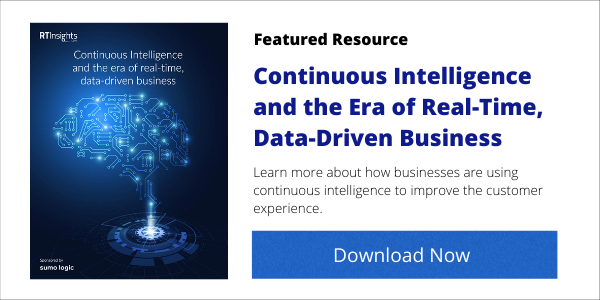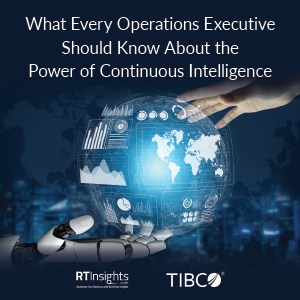
Businesses need a view into complex digital systems. One option being considered is a solution that provides greater observability based on continuous intelligence.
There is an increased importance for delivering a good experience as organizations offer more of their services digitally. Some may argue that this need is no different than when dealing with customers in person. But that would be a wrong assumption.
Consider the contrast between the digital and in-person user experience to see why a good experience tailored for each environment is necessary.
![Featured Resource: Continuous Intelligence and the Era of Real-Time, Data-Driven Business [Download Now]](https://no-cache.hubspot.com/cta/default/8019034/9769f547-fc63-40f1-b242-fd20e3451bf3.png)
Unhappy customers can more easily take their business elsewhere in the digital domain. If an in-store customer is unsatisfied, they may decide to just accept matters and buy a product because going somewhere else is time-consuming, or there may not be another local option.
If an online customer has a bad experience, a competitor’s offerings are just a click away. All it takes is a simple search to find alternatives. And given the use of cookies, a customer may already be seeing ads from your competitors as they read their online news or conduct other business.
So, digital engagements must take good customer experience to new levels.
See also: Reliability is the Backbone of Digital Business
Cornerstones of a good digital customer experience
Happy customers are loyal, bring in recurring revenue thanks to repeat business, and help attract new customers by telling their friends. So, how do you keep them happy when they engage your business digitally?
The two most important aspects to delivering a good customer experience digitally are availability and performance.
If a site or digital service is down, the company loses immediate business from that particular engagement. How much? The dollar value can be staggering. Major online sites, ranging from Target to Amazon, experience a revenue loss of between $10,000 to $220,000 per minute, based on online revenue metrics calculations. And worse, a company could lose the customer forever if that customer quickly finds comparable offerings from a competitor.
Simply having services up and running is not enough. They must be responsive. Poor performance irritates customers and leads to bad results. For example, a decade ago, Amazon found that a 100-millisecond latency increase costs them 1% in sales. In 2017, Akamai found that a 100-millisecond delay in website load time can lower conversion rates by 7%. And, in 2018, Google found that when a page load time increases to three seconds from one second, the bounce probability goes up by more than 30%. These issues likely cause an even greater impact today as customers spend so much more time online.
Challenges to overcome
Ensuring high availability and performance is no simple matter. New digital products and services are created differently than traditional web and software products. In particular, new digital offerings are typically delivered via modern software apps, which are conglomerates of many smaller elements running on-premises or in public clouds. They use cloud computing services and are frequently based on microservices. And some of the application components are supplied by partners and third parties.
On the plus side, these new methods often help improve availability and performance. For example, elements running on cloud services easily scale and have built-in resiliency. Similarly, an application based on microservices can be more easily maintained and updated. Only a small portion of an application needs to be worked on versus re-writing an entire monolithic application or taking the whole application offline to make even a small update.
These benefits come at the expense of added complexity. The explosion of components and users drives data volume growth. And the real-time nature of business and the agile rate of change drives data velocity. Such new data challenges are much larger than the “big data” problems of 10 years ago. They require a new approach and tools that traditional data center tools can no longer address. Specifically, a differentiated digital experience needs a data-driven methodology that:
- Integrates and manages a multi-cloud infrastructure and technology stack.
- Integrates and manages Kubernetes, containers, serverless, and other microservices technologies.
- Handles highly unstructured data without having to know data structure in advance.
- Scales to mimic scaling required by applications and products being managed.
- Keeps sensitive customer data secure in a compliant manner.
- Collects and analyzes all data signals (logs, traces, and metrics) in an integrated manner.
- Applies advanced analytics to detect and explain unknown unknowns resulting from the rate of change.
Enter continuous intelligence
Beyond traditional monitoring tools, businesses need a view into complex digital systems that no human can see with their own eyes. One option that businesses are considering is greater observability based on continuous intelligence. It’s a technology concept that collects data such as system metrics in real time from a range of systems. It then analyzes that fresh data – along with historical data – for usage trends, performance, and potential issues, whether hardware, software, or network-based.
See also: Continuous Intelligence Insights
A continuous intelligence system leverages AI and machine learning to analyze new and past data. It also draws on a knowledge base built by human operations staff. Such knowledge helps CI understand normal system behavior and proven problem fixes. When the system detects an aberration, it can issue an alert to the operations staff, or in some cases, implement a pre-programmed fix.
What continuous intelligence offers is the ability to learn about system behaviors over time. In some cases, it can self-identify relationships and dependencies among systems and applications that humans may not recognize. That discovery of inter-system relationships may ensure that multiple apps and databases are treated holistically.
Such capabilities are critical in businesses offering digital products and services. They help the business ensure their offerings stay up and running and meet customer performance expectations. As such, CI can help deliver the exceptional experiences needed to retain and attract existing and new customers.







